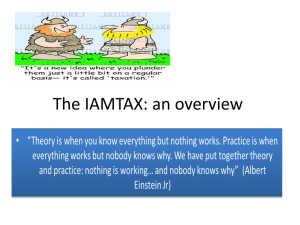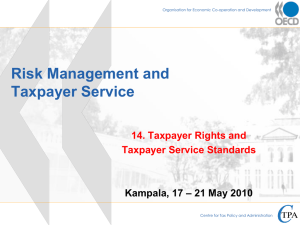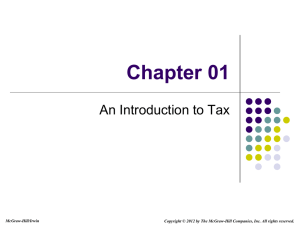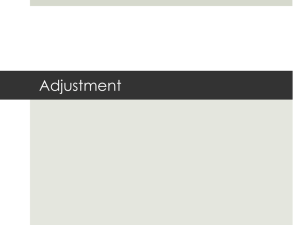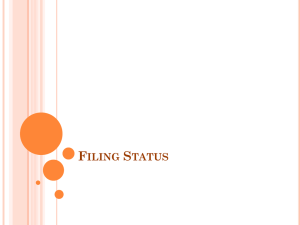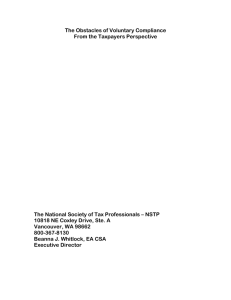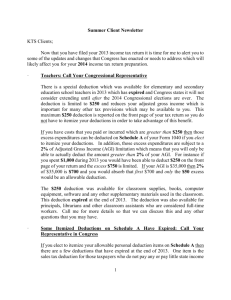OECD/IMF/World Bank Meeting in Paris
advertisement
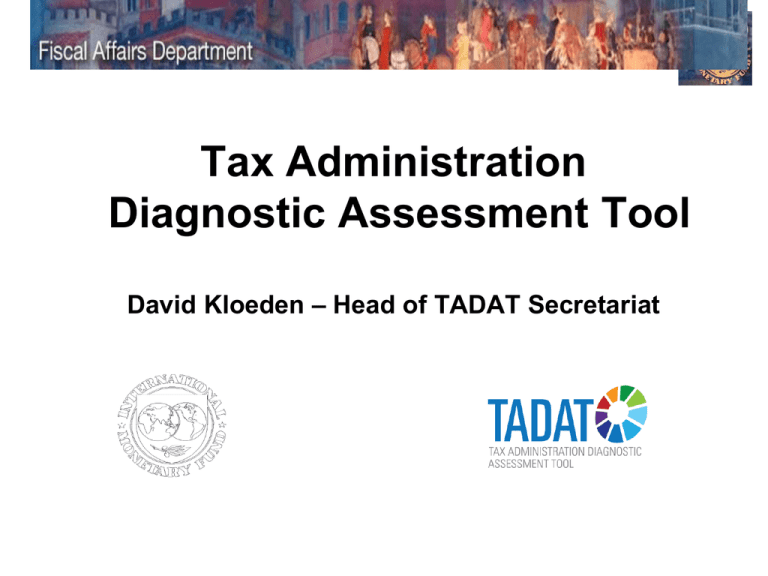
Tax Administration Diagnostic Assessment Tool David Kloeden – Head of TADAT Secretariat Key Design Elements A framework that is designed to deliver objective assessments of the most critical outcomes of a tax administration A tool that allows for repeated measurement over time of the performance of a country’s tax administration A tool that will allow for some level of country comparison when sufficient applications of the tool have been completed A tool that is aligned with the design of the PEFA PFM tool and can be used by any agency A tool that focuses on performance of major national taxes: □ Corporate and personal income tax □ VAT □ Employer and other withholding taxes 2 Intended Outcomes Better identification of the relative strengths and weaknesses in the tax administration Facilitating discussion towards a shared view among stakeholders Improvements in setting reform objectives, establishing priorities and implementation sequencing – and strengthening of design of tax administration reform initiatives Better coordination of external support for reforms – faster and more efficient implementation Provides a basis for monitoring and evaluating reform progress towards established targets through repeat assessments 3 Assessment of Performance TADAT framework comprising 9 performance outcome areas (POAs) Across a Set of 27 high-level indicators critical to tax administration performance. That drill down to 60 measured and scored Dimensions 4 Performance Outcome Area Structure 5 Desired End State - Performance Outcome Areas 1. Taxpayers are included in the taxpayer registration base and the information held about them is accurate 2. The tax administration is clear about the risks to the tax system and is responding to them 3. Taxpayers have the necessary information and encouragement to voluntarily comply 4. Taxpayers file their tax returns as required by law 5. Taxpayers meet their payment obligations 6. The tax administration assesses the accuracy of reporting through verification 7. The dispute resolution process is independent and effective 8. The tax administrations operations are efficient and focus on the most important tax administration functions 9. The tax administration is transparent in the conduct of its activities and accountable to the government and the community 6 Examples of Indicators and Measured Dimensions Integrity of the Registered Taxpayer Base Tax administrations must compile and maintain a complete database of citizens and businesses that are required by law to register. Without complete and accurate information on registered taxpayers, and an understanding of the profile of those who fail to register, a tax administration cannot provide effective services to support voluntary compliance and take action against non-compliance. Two performance indicators (with 3 measurement dimensions) are used to assess POA 1. 7 POA 1: Integrity of the Registered Taxpayer Base Indicator Accurate and reliable information Knowledge of the potential taxpayer base Dimensions to be measured • The adequacy of information held on registered taxpayers and the extent to which the registration database supports effective compliance management. • The accuracy of information held in the registration database. • The extent of initiatives to detect individuals and businesses that are required to register but fail to do so. 8 Examples of Indicators and Measured Dimensions Assessment of Risk Understanding the risks in the tax system is critical to managing taxpayer compliance, including how tax administration resources are allocated to achieve the widest possible impact on voluntary compliance across the taxpayer population. Institutional risks, such as IT system failure, must also be managed. Three performance indicators (with 5 measurement dimensions) are used to assess POA 2. 9 POA 2: Assessment of Risk Indicator Dimensions to be measured The process used to identify, assess, and prioritize taxpayer compliance risks. The process used to estimate the scale of tax revenue leakage. Identification, assessment, ranking and quantification of institutional risks. The process used to identify, assess and prioritize tax administration institutional risks. Design, implementation, monitoring and evaluation of risk mitigation activities. The action taken and resources applied to respond to the highest compliance and institutional risks. The process used to monitor and evaluate the impact of risk mitigation activities. Identification, assessment, ranking and quantification of compliance risks. 10 Examples of Indicators and Measured Dimensions Filing of tax returns Filing of tax returns is a principal means by which a taxpayer’s tax liability is established and becomes due and payable under the law. Filing performance has a direct impact on collections. Two performance indicators (with 8 measurement dimensions) are used to assess POA 4. 11 POA 4: Filing of Tax Returns Indicator Tax return filing rate Dimensions to be measured The number of returns filed in % of the total number of returns required from registered taxpayers for each core tax: - Corporate income tax (CIT) - Personal income tax (PIT) of self-employed - Value added tax (VAT) - Pay-as-you-earn (PAYE) withholding On-time filing rate The number of returns filed by the statutory due date in % of all returns filed for each core tax: - CIT - PIT self-employed - VAT - PAYE withholding 12 Scoring the Indicators Indicators All have between 1 to 4 dimensions Each dimension is separately assessed Overall score for an indicator is based on the assessment of the dimensions related to that indicator: Method 1 – Single dimension indicators Method 2 – Multiple dimension indicators Scores A B C D 'A' is set as "internationally accepted good practice", with the lower grades increasing deviations from this Also a ‘No score’ category 13 Process of an Assessment Assessment will be undertaken by accredited assessors Assessors will use the indicator-led analysis and be supported by: Initial training Performance measurement framework Comprehensive field guidelines A Performance Assessment Report will be prepared to formalize the findings. 14 Proof of Concept Testing Pilot Assessment Missions across a wide-range of situations: Level of Economic Development Region, Language, and Heritage Economic and Governance Characteristics November 2013 - First Pilot in Zambia December 2013 - Second Pilot in Norway June 2014 -Third Pilot in South Africa July – Nov 2014 - 3 further pilot assessments possibly in: Latin America, possibly in Spanish Middle East, possibly fragile state Asia Pacific Deliver Collaboratively with Regional Tax Admin Organizations 15 Governance Arrangements Steering Committee Officially formed February 2014 Composition – Donors (including the EC), IMF and World Bank Functions - Strategic guidance Secretariat Composition – IMF Functions - Design & maintenance of the tool - Program delivery - Results management - Accountability - - Quality control - Financial arrangements - Evaluation Technical Advisory Group Composition – International tax administrations and organizations Functions - Technical support to the Secretariat 16 Timetable Current priorities Finalizing the detailed technical design Finalizing operational guidance (Field Guide) Further piloting (further 4 pilots in 2014) June 2014 - Next Steering Committee January-June 2015 - Implementation in controlled roll out phase Mid-2015 - Full production mode 17
